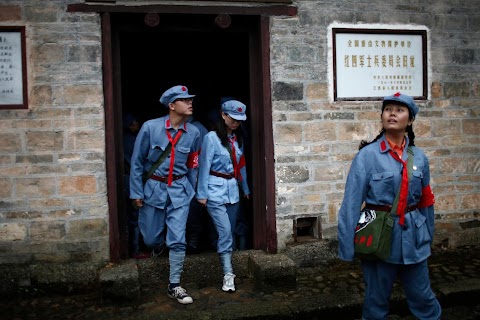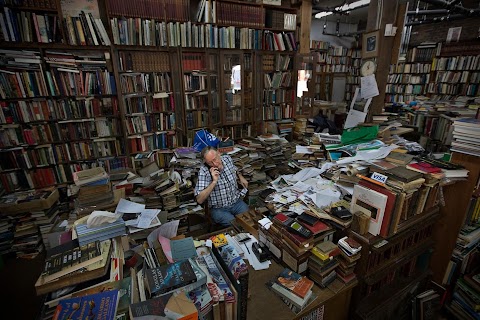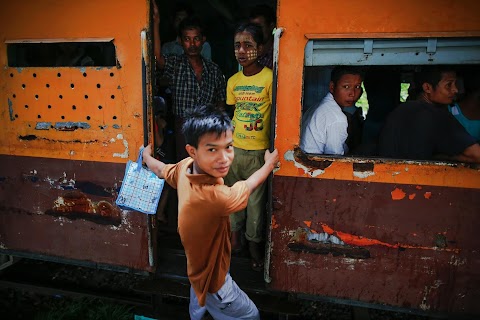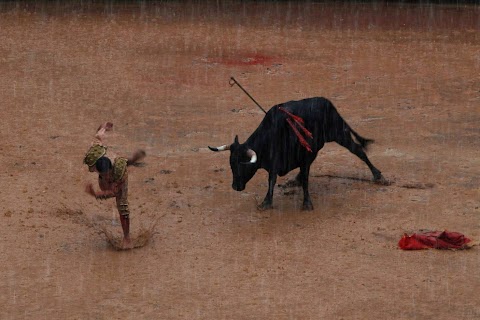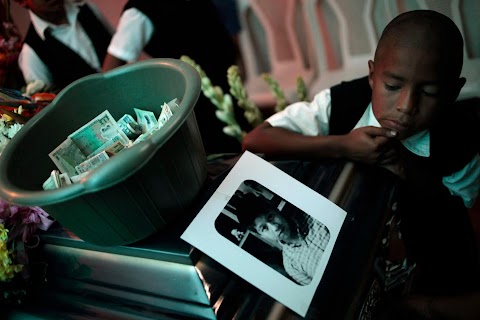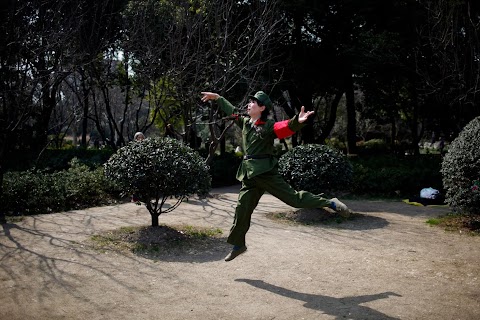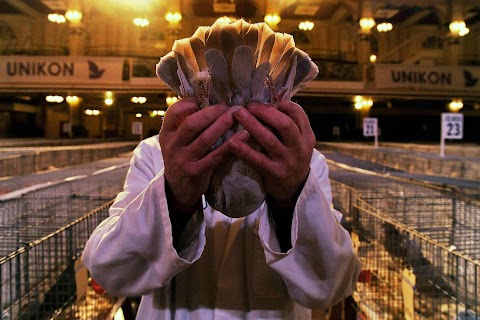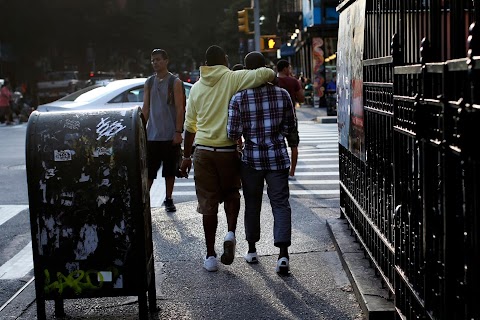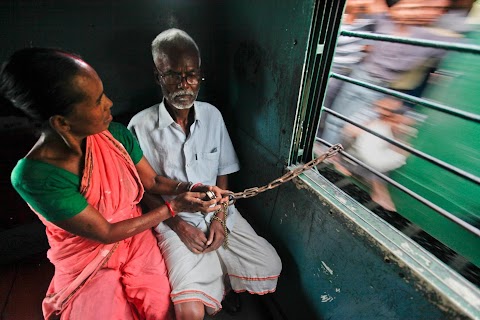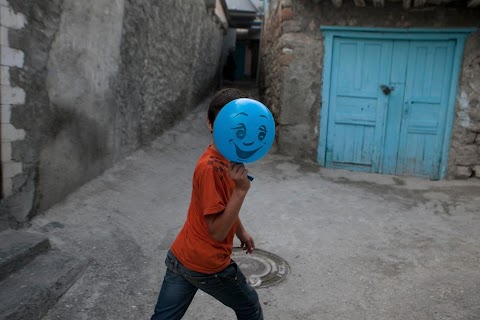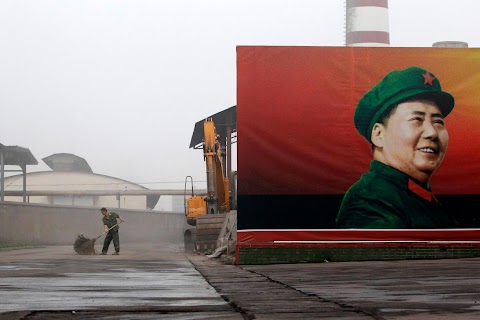
China's model Communism
The figure of Chairman Mao Zedong looms large, both literally and metaphorically, in Nanjie village. This settlement of over 3,100 residents is a place where the late Chairman Mao's principles of morality and collectivism are still supposed to strictly guide people's daily lives.

Mao Zedong’s face is shown all over Nanjie, and he enjoys an almost god-like status in the village. A giant statue of the late Chinese leader stands in the middle of the square in the town centre, and next to him are portraits of four other famous Communists: Karl Marx, Friedrich Engels, Vladimir Lenin and Joseph Stalin.

A resident stands on the balcony of her welfare-funded house, which is just part of the ample package of support that members of the community receive in Nanjie. In addition to free housing, healthcare, food rations and education, locals working in the village's factories receive an average salary of 2500 yuan, about 400 dollars.

The village's return to a traditional form of Communism came at the same time as the rest of the country opened up to the capitalist market in the mid 1980s.
Slideshow

Residents sit near portraits of famous Communist leaders Vladimir Lenin and Joseph Stalin in Dong Fang Hong Square.

Two soldiers leave Dong Fang Hong Square after standing guard at the statue of Chairman Mao.

A worker cycles past a Nanjie Cun Group thermal power plant in the village.

Nanjie residents push lawn mowers down the street.

Students practice Chinese martial arts in Nanjie village.

A student at an art school practices in front of a poster showing a portrait of the late Chairman Mao, alongside characters from Chinese revolutionary drama.

Residents work on a production line at an instant noodle factory.

A worker checks a machine at the printing factory.

Elderly locals eat their lunch at a nursing home in the village.

A Nanjie resident holds out his meal tickets.

One village resident takes some exercise.

A girl sits beneath a picture of Chairman Mao in a souvenir shop beside Dong Fang Hong Square in Nanjie village.

An elderly couple drives past the square.

A statue of Mao Zedong stands tall in the village’s Dong Fang Hong Square.
"Even though the actual workings of the society still puzzle me, I was intrigued by the lifestyle in Nanjie."
It only takes an hour-and-a-half long flight and a one-hour drive to travel from China’s modern cultural and political centre, Beijing, to Nanjie village – a place where the late Chinese Chairman Mao Zedong’s original ideas about morality and collectivism are still supposed to govern people’s daily lives.
Honestly, I didn’t expect getting into Nanjie to be so easy. There were no entrance tickets, no security guards, and no one had to check our vehicle. We drove all the way to the village centre, where a giant statue of Chairman Mao stood in the middle of a square, waving at me. Next to him were four portraits of his Communist comrades: Karl Marx, Friedrich Engels, Vladimir Lenin and Joseph Stalin. The loudspeakers in the square repeatedly played the classic revolutionary song “The East Is Red”; the same song that played in outer space in 1970 after China’s first satellite was put into orbit.
The entire Nanjie village consists of dozens of factories and several main streets. Mao Zedong's face is everywhere. There were very few people or cars on the street while we were there, which may have been the reason why all the traffic lights in the village were not working, not even at the crossroads. I jumped up and down with my cameras in the middle of the road to get good angles, something that could easily get me killed if I were in a different town. But luckily the people of Nanjie seemed to move at a slow pace and be pleasant.
The next morning, a worker approached me on the street and said: “Welcome to Nanjie Village!” I was deeply flattered, because it is difficult to have a casual conversation in China with a complete stranger and I was dying to talk to local residents. I wanted to know how they felt about everything in the village, how they felt about their lives. So I asked my questions to the middle-aged worker, Mr. Wang.
His answer was only one word: “Zhong”, a word in the Henan dialect that means “wonderful.” He went on to explain that many of life’s necessities were free in the village, including housing, health care, education and food. He said this made people living in other places feel embarrassed, because even Chinese white-collar workers have to spend most of their salary on mortgage and credit card payments, while praying to God they never get sick.
I asked him why other places in China couldn’t replicate what Nanjie has, even though all of China is under the same social system? Why, in other places, would a person take advantage of others just to get more money? He replied that it was because of people’s selfishness. He believed that selfishness was the root of all sorts of destruction. However, in Nanjie, people were doing the very opposite of being selfish – they were sharing. Selfish people would be isolated in this place, he said.
At the end of our chat, I asked whether he had ever been to a capitalist country. He said he had been to Japan. “Japan’s social system is also good (comparing it to Nanjie’s), and it is also more modernised, especially in education,” he told me.
As I bid farewell to Mr. Wang, he gave me a handbook titled “Understanding Nanjie Village.” Browsing through the pages, I saw many grandiose mottos recited by the village Communist Party Secretary (head of the village) Wang Hongbin. “Money is poison in an individual’s hand, but fortune in a collective’s hand,” said one. “Make the people in Nanjie village so rich that they don’t have any deposit,” said another.
I have to admit, even though the actual workings of the society still puzzle me, I was intrigued by the lifestyle in Nanjie. I wanted to stay longer, but soon realised that it was the end of month and I still had a bunch of credit card bills to pay. I snapped back to reality.




